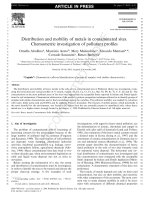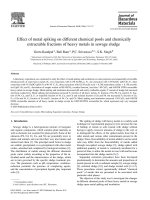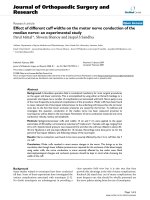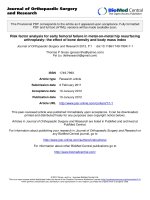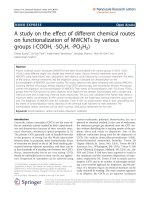Effect of metal spiking on different chemical pools and chemically extractable fractions of heavy metals
Bạn đang xem bản rút gọn của tài liệu. Xem và tải ngay bản đầy đủ của tài liệu tại đây (205.28 KB, 5 trang )
Journal of Hazardous Materials 106B (2004) 133–137
Effect of metal spiking on different chemical pools and chemically
extractable fractions of heavy metals in sewage sludge
Geeta Kandpal
a
, Bali Ram
a
, P.C. Srivastava
b,∗
, S.K. Singh
b
a
Department of Chemistry, G.B. Pant University of Agriculture and Technology, Pantnagar 263 145, India
b
Department of Soil Science, G.B. Pant University of Agriculture and Technology, Pantnagar 263 145, India
Received 25 February 2003; received in revised form 28 October 2003; accepted 31 October 2003
Abstract
A laboratory experiment was conducted to study the effect of metal spiking and incubation on some properties and sequentially extractable
chemical pools of some heavy metals (F
1
, two extractions with 0.1M Sr(NO
3
)
2
;F
2
, one extraction with 1M NaOAc (pH 5.0); F
3
, three
extractions with 5% NaOCl (pH 8.5) at 90–95
◦
C; F
4
, three extractions with 0.2M oxalic acid + 0.2 M ammonium oxalate + 0.1 M ascorbic
acid (pH 3.0); and F
5
, dissolution of sample residue in HF–HClO
4
(residual fraction,) and also 1M CaCl
2
and 0.005 M DTPA extractable
heavy metals in sewage sludge. Metal spiking and incubation decreased pH and easily oxidizable organic C content of sludge but increased
electrical conductivity. Metal spiking and incubation increased F
1
fraction of all heavy metals, F
2
fraction of Ni, Pb, Cu, and Cd, F
3
frac-
tion of Pb, Cu, and Cd, F
4
or reducible fraction of Ni, Cu, and Cd and residual fraction of Zn and Pb, but decreased F
2
fraction of Zn,
F
3
of Zn and Ni, F
4
fraction of Zn and F
5
fraction of Ni, Cu, and Cd. Metal spiking and incubation increased 1 M CaCl
2
and 0.005 M
DTPA extractable amounts of all heavy metals in sludge except for 0.005 M DTPA extractable Zn, which registered only very marginal
decrease.
© 2003 Published by Elsevier B.V.
Keywords: Extractable heavy metals; Metal spiking; Sequential extractions; Sewage; Sludge
1. Introduction
Sewage sludge is a heterogeneous mixture of inorganic
and organic components, which contains plant nutrients as
well as elements not essential for plant growth. Some of the
elements (Pb, Cd, Cr, Cu, and Ni) are potentially toxic to
plants and animals and can find their way into human and
animal food chain [1]. The principal metal forms in sludge
are soluble, precipitated or co-precipitated with other metal
oxides, adsorbed and complexed by biological residues [2].
The distribution of metals among the different chemicals
pools varies widely according to the properties of the in-
dividual metal and the characteristics of the sludge, which
are in turn governed by the specific sludge treatment pro-
cess. The parameters such as pH, temperature, oxidation–
reduction potential, the presence of complexing agents,
and the concentration of precipitant ligands play important
roles [3].
∗
Corresponding author.
E-mail address: (P.C. Srivastava).
The spiking of sludge with heavy metals is a widely used
technique for experimental purposes [4] to increase the rate
of buildup of metals in soils treated with sludge without
having to apply excessive amounts of sludge to the soil, or
to distinguish the effects of the spiked metals from that of
other metals and various other contaminants present in the
sludge. Since, bioavailability of metals added to soil as metal
salts may differ from the bioavailability of metals added
through non-spiked sewage sludge [5], sludge spiked with
additional quantity of metals is commonly incubated for a
period of time, to allow the metals to react with and become
incorporated into the sludge matrix [6,7].
Sequential extraction procedures have been developed
predominantly to determine the amounts and proportions of
metals present in soil or sediment sample [8], sewage sludge
[9], enriched sludge [10], and sludge treated soils [11,12].
These procedures extract operationally defined “chemical
pools” of metals that are presumed to be associated with
particular solid phases.
The objective of this study was to investigate the changes
in different chemical pools of these heavy metals in sewage
sludge upon metal spiking and incubation.
0304-3894/$ – see front matter © 2003 Published by Elsevier B.V.
doi:10.1016/j.jhazmat.2003.10.006
134 G. Kandpal et al./ Journal of Hazardous Materials 106B (2004) 133–137
2. Experimental
2.1. Sludge
Bulk sample of sewage sludge was collected in plastic
bags from Karula drain of Moradabad, UP, India, a city
having brass plating and policing industrial units. The sam-
ple was processed to remove the non-recyclable materials
and passed through a sieve having openings of diameter
2 mm.
One kilogram of sludge (on dry weight basis) was spiked
with 100ml of a solution containing 1000mg Zn, Ni, and
Pb, 500mg Cd and 2000 mg Cu/l in the form of zinc sulfate,
nickel chloride, lead acetate, cadmium chloride, and copper
sulfate. Moist slurry was thoroughly stirred and incubated
at 30% moisture content at 27–29
◦
C for 1 month. After
incubation, the treated sludge was again thoroughly stirred.
Triplicate samples of both unspiked and metal spiked sludge
were drawn for chemical analysis.
2.2. Chemical analysis
Both metal spiked and unspiked samples of sludge were
analyzed for pH, electrical conductivity in 1:2 sludge:water
suspension and easily oxidizable (wet oxidation by chromic
acid) organic C content [13].
Total contents of heavy metals in both unspiked and metal
spiked samples of sludge were determined in HF–HClO
4
digest by atomic absorption spectrophotometry [14]. The
total content of these metals in both unspiked and metal
spiked samples of sludge are given in Table 1.
Sludge samples were subjected to sequential extraction
in triplicate as per the scheme given by [15] to obtain the
following five operationally defined chemical pools.
Two extractions with 0.1 M Sr(NO
3
)
2
(soluble + excha-
ngeable form, F
1
), one extraction with 1 M NaOAc (pH
5.0) (specifically sorbed and carbonate bound form, F
2
),
three extractions with 5% NaOCl (pH 8.5) at 90–95
◦
C (or-
ganically bound or oxidizable fraction, F
3
), three extrac-
tions with 0.2 M oxalic acid + 0.2M ammonium oxalate
+ 0.1M ascorbic acid (pH 3.0) extractable (reducible form,
F
4
) and dissolution of remaining amount of metals in sam-
ple through HF–HClO
4
digestion (residual fraction, F
5
).
All extracts separated through centrifugation from F
1
to F
3
were acidified to 0.16 M HNO
3
. A drop of toluene was
Table 1
Some properties and total content of heavy metals in unspiked and spiked samples of sludge
Contents (mgkg
−1
) Other properties
Ni Zn Pb Cu Cd pH EC % OC
E. sludge 257.62
∗∗
2225.75
∗∗
407.62
∗∗
1517.37
∗∗
53.75
∗∗
5.22
∗∗
1.14
∗∗
4.80
∗∗
Sludge 168.00 2164.00 340.50 1434.50 16.00 6.29 0.44 5.46
∗∗
Significant at P = 0.01 for paired t-test.
added to F
4
fraction to prevent bacterial growth in extract.
These sequential extraction procedures extract some oper-
ationally defined ‘chemical pools’ of heavy metals which
could be presumed to be associated with particular solid
phase.
The sludge and spiked sludge samples were also ana-
lyzed in triplicate for 0.005 M DTPA- [16] and 1M CaCl
2
-
extractable heavy metals [17]. All the extracts were analyzed
for heavy metals by atomic absorption spectrophotometry.
3. Results and discussion
3.1. Properties of sludge
Metal spiking and incubation of sludge led to decrease
the pH of sludge by about one unit and increased electrical
conductivity more than two-fold (Table 1). Easily oxidizable
content of organic C in metal-spiked sludge after 1-month
incubation was also significantly lower than that of unspiked
sludge. This indicated microbial oxidation of organic C
present in sewage sludge during incubation. Metal-spiking
markedly increased the total content of Ni, Cd, and Pb in
the sludge but spiking had relatively little effect on total
Cu and Zn which could be ascribed to the fact that the un-
spiked sludge had initially much higher concentration of Zn
and Cu, and therefore, spiking brought in only little relative
change in the total concentrations of these metals in sludge.
3.2. Chemical pools of heavy metals
Among various chemical pools, major portion of metals
in unspiked sludge occurred in the residual fraction (F
5
)
followed by F
3
,F
2
,F
4
, and least being observed in soil
solution (exchangeable, F
1
) fraction, which is considered to
be an immediately bioavailable form (Table 2). However, in
case of Cu and Pb, the second most dominant fraction next
to F
5
fraction was F
2
, possibly indicating the tendency of
these metals to enter in carbonates in the sludge materials.
A similar sequence was reported earlier also [18]. Higher
content of the F
3
and F
5
fractions of heavy metals could
explain the lower concentration of heavy metals in F
2
and
F
1
fractions [19]. This might be ascribed to the presence
of unoxidized organic matter and the higher pH value of
unspiked sludge.
G. Kandpal et al./ Journal of Hazardous Materials 106B (2004) 133–137 135
Table 2
The contents of heavy metals in different chemical pools, DTPA And 1M CaCl
2
extracts in sewage sludge (SS) and heavy metal spiked, incubated
sewage sludge (HMSS) samples
Contents (mgkg
−1
)
Ni Zn Pb Cu Cd
SS HMSS SS HMSS SS HMSS SS HMSS SS HMSS
Water soluble + exchangeable (F
1
) 17.1** 114.5 49.8** 54.1 0.6** 2.6 4.3** 120 0.6** 35.4
Carbonate bound (F
2
) 25.9** 50.5 51.8** 46.5 67.6** 93.2 102.9** 534.3 1.4** 9.7
Organically bound (F
3
) 39.2** 21.5 125.6** 115.9 17.1** 32.4 83.0** 174.1 1.5** 4.1
Reducible (F
4
) 11.7** 16.3 181.0** 171.1 2.8NS 2.0 63.9** 396.4 0.2* 0.3
Residual (F
5
) 74.1** 54.8 1755.8** 1838.1 252.4** 276.9 1180.4** 292.6 12.3** 4.3
DTPA 36.4** 93.4 59.7** 57.3 2.2** 11.7 119.1** 416.3 2.0** 22.8
1 M CaCl
2
32.6** 52.6 51.3** 53.5 2.9** 10.9 29.7** 197.2 1.9** 15.5
**, * and NS indicate significance at P = 0.01, 0.05 and non-significant difference between pairs, respectively.
3.3. Effect of metal spiking and incubation on
chemical pools
Heavy metal spiking and incubation significantly in-
creased the F
1
fraction of all metals in sludge, however,
the effect was very small in case of Zn (Table 2). The F
2
fraction of Ni, Cd, Pb, and Cu in sludge also significantly
increased but that of Zn was about the same with metal
spiking and incubation probably because Zn spiking had
little effect on total Zn.
The F
3
fraction of Pb, Cu, and Cd significantly increased
in sludge with metal spiking and incubation, but that of Ni
and Zn suffered a decrease. Metal fraction of Ni, Cu, and Cd
in F
4
fraction, i.e. largely Fe–Al oxides bound fraction sig-
nificantly increased while that of Zn significantly decreased
with metal spiking and incubation. The F
5
(residual) frac-
tion of Zn and Pb significantly increased with metal spik-
ing and incubation while that of Ni, Cu, and Cd registered
a significant decrease. Based upon the changes in different
chemical pools of heavy metals in sludge due to metal spik-
ing and incubation, it appeared that bio-oxidation of organic
carbon and consequent acidification effected release of Ni,
Cu, and Cd from F
5
(residual fraction), of Ni and Zn from
F
3
fraction, of Zn from F
4
and F
2
fractions from sludge.
The released and added metals were incorporated into F
5
(residual) fraction in case of Zn and Pb, into F
4
(reducible
or Fe–Al oxide bound) fraction in case of Ni, Cu, and Cd,
into F
4
fraction in case of Pb, Cu, and Cd, into F
2
fraction
in case of Ni, Cd, Pb, and Cu and invariably increased the
F
1
fraction (water soluble and exchangeable form) of all the
tested heavy metals.
Heavy metal spiking and incubation significantly in-
creased 1 M CaCl
2
extractable content (water soluble and
exchangeable) of all heavy metals in sludge except Zn which
registered only a minor increase. The 0.005M DTPA (pH
7.3) extractable content of all heavy metals in sludge also
significantly increased with metal spiking and incubation.
This chelating agent is supposed to partly extract metals
from most chemical pools [20] except the F
5
(residual)
fraction.
The percent distribution of different chemical pools of
heavy metals in sludge and metal-spiked incubated sludge
is depicted in Fig. 1.
Spiking and incubation appeared to increase the propor-
tions of Cd and Ni in F
1
and F
2
fractions at the expanse of
F
5
and F
4
fractions which might be due to oxidative break-
down of organic components during incubation as well as
dissolution of Fe–Mn oxides. This result suggests that there
might be higher mobility of Cd and Ni when added through
enriched sludge to the soil.
A high proportion of Zn occurred in the F
5
(residual pool)
and could be related to the preferential binding of Zn for
high energy sites on clay minerals present in the sludge or
conversion to insoluble solid phase like ZnS. In the case of
Pb, a small increase in the percentage of F
2
and F
1
fractions
might be due to a decreased residual Pb proportion in the
spiked sludge.
Spiking and incubation also appeared to increase the Cu
percentage in all the chemical pools (fractions) except F
5
(residual fraction). The greatest increase was observed for
the F
4
fraction which might be due to the high affinity of
Cu for Fe–Mn oxides [21,22]. The increase in F
3
fraction
was observed for Cu and Pb in spiked sludge. This result
is consistent with the known affinity of copper and lead for
organic ligands [23].
The changes in per cent fractions of heavy metals ex-
tracted in 1M CaCl
2
and 0.005 M DTPA (pH 7.3) upon
metal spiking and incubation are depicted in Fig. 2. The in-
crease in percentage of 1 M CaCl
2
extractable heavy metal
upon metal-spiking and incubation was most pronounced for
Cu followed by Cd and Pb, but least marked for Ni and Zn.
The increase in percentage of 0.005M DTPA extractable
heavy metal upon metal-spiking and incubation was most
pronounced for Cd followed by Cu, Pb, and Ni. The percent-
age of 0.005M DTPA (pH 7.3) extractable Zn underwent a
little decrease which could be anticipated in view of a small
difference in Zn content spiked and unspiked sludge.
The observed difference in metal distribution among op-
erationally defined chemical pools in unspiked and spiked
sludge could well have implications on the mobility and/or
136 G. Kandpal et al./ Journal of Hazardous Materials 106B (2004) 133–137
Fig. 1. Mean percentage of different chemical pools of heavy metals in sewage sludge and metal spiked, incubated sewage sludge samples (all pairs of
respective pools between sewage sludge and metal spiked, incubated sewage sludge samples were significantly different as per paired t-test at P = 0.05
except for F
4
pool of Pb).
Fig. 2. Mean percentage of total metals extracted in 1 M CaCl
2
and 0.005 M DTPA from sewage sludge and heavy metal enriched, incubated sewage
sludge samples (all pairs between sewage sludge and heavy metal spiked, incubated sewage sludge were significantly different as per paired t-test).
bioavailability of these metals when the sludges are applied
to soil.
However, application of sludge to the soil is also likely to
result in changes in the distribution of metals among chem-
ical pools.
4. Conclusion
The results obtained from this study demonstrated that
when sewage sludge is spiked with additional metals added
as simple salts and incubated, some physico-chemical prop-
erties like pH, EC, and also easily oxidizable organic C
content change and substantial proportions of the metals be-
come incorporated into the sludge matrix. In case of Zn, the
fractional distribution of Zn between spiked and non-spiked
sludge remains more or less similar principally due to the
minor difference in their total Zn content but in the case of
other heavy metals such as Ni, Cu, Pb, and Cd the intensi-
ties of different chemical pools are altered to influence the
bioavailability of these metals in metal spiked and incubated
sludge.
G. Kandpal et al./ Journal of Hazardous Materials 106B (2004) 133–137 137
References
[1] M.B. McBride, Toxic metal accumulation from agriculture use of
sludge. Are USEPA regulations protective, J. Environ. Qual. 24
(1995) 5–18.
[2] J.N. Lester, R.M. Sterritt, P.W.W. Kirk, Significance and behaviour of
heavy metals in wastewater treatment processes. II. Sludge treatment
and disposal, Sci. Total Environ. 30 (1983) 45–83.
[3] M.S. Gould, E.J. Genetelli, Heavy metal complexation behaviour
in anaerobically digested sludges, Water Res. 12 (1978a) 505–
512.
[4] J.J. Street, W.L. Lindsay, B.R. Sabey, Solubility and plant uptake
of cadmium in soils amended with cadmium and sewage sludge, J.
Environ. Qual. 6 (1977) 72–77.
[5] P.F. Bell, B.R. James, R.L. Chaney, Heavy metal extractability in
long term sewage sludge and metal amended soils, J. Environ. Qual.
2 (1991) 481–486.
[6] R.D. Davis, C.H. Carlton-Smith, The preparation of sewage sludges
of controlled metal content for experimental purposes, Environ. Pol-
lut. 2 (1981) 167–177.
[7] S. Coppola, S. Dumontet, M. Pontonio, G. Basile, P. Marino, Effect of
cadmium bearing sewage sludge on crop plants and microorganisms
in two different soils, Agric. Ecosyst. Environ. 20 (1988) 181–194.
[8] L.M. Shuman, Fractionation methods for soil microelements, Soil
Sci. 140 (1985) 11–12.
[9] R.C. Stover, L.E. Sommers, D.J. Silviera, Evaluation of metals in
wastewater sludge, J. Water Pollut. Control Fed. 48 (1976) 2165–
2175.
[10] R.G. McLaren, L.M. Clucas, Fractionation of copper, nickel and zinc
in metal spiked sewage sludge, J. Environ. Qual. 30 (2001) 1968–
1975.
[11] D.L. Lake, P.W.W. Kirk, J.N. Lester, Fractionation, characterization
and speciation of heavy metals in sewage and sludge amended soils.
A review, J. Environ. Qual. 13 (2) (1984) 175–183.
[12] S. Dudka, A. Chlopecka, Effect of solid-phase speciation on metal
mobility and phytoavailability in sludge amended soil, Water, Air
Soil Pollut. 51 (1990) 153–160.
[13] M.L. Jackson, Soil Chemical Analysis, Prentice Hall, New Jersey,
USA, 1958, pp. 38–226
[14] A.L. Page, R.H. Miller, D.R. Keeney, Chemical and microbiological
properties, in: Methods of Soil Analysis, second ed., ASA, SSSA,
Madison, WI, 1982, p. 1159.
[15] Z.S. Ahnstrom, D.R. Parker, Development and assessment of a se-
quential extraction procedure for the fractionation of soil cadmium,
Soil Sci. Soc. Am. J. 63 (1999) 1650–1658.
[16] W.L. Lindsay, W.A. Norvell, Development of a DTPA soil test for
zinc, iron, manganese and copper, Soil Sci. Soc. Am. J. 42 (1978)
421–428.
[17] S.D. Young, A. Tye, A. Carstensen, L. Resende, N. Crout, Methods
for determining labile cadmium and zinc in soil, Eur. J. Soil Sci. 51
(2000) 129–136.
[18] T. Chitdeswari, P. Savithri, S. Mahimairaja, Fractionation and char-
acterization of sewage sludge, J. Ecotoxical. Environ. Monit. 12 (2)
(2002) 161–165.
[19] G. Brummer, K.G. Jiller, U. Herms, P.N. Clayton, Adsorption–
desorption and/or precipitation–dissolution processes of zinc in soils,
Geoderma 31 (1983) 337–354.
[20] W.F. Pickering, Metal ion speciation—soils and sediments. A review,
Ore Geol. Rev. 1 (1986) 83–146.
[21] D.G. Kinniburgh, M.L. Jackson, J.K. Syers, Adsorption of alkaline
earth, transition and heavy metal cations by hydrous oxide gels of
iron and aluminum, Soil Sci. Soc. Am. J. 40 (1976) 796–799.
[22] J.W. Murray, The interaction of metal ions at the manganese dioxide
solution interface, Geochim. Cosmochim. Acta 39 (1975) 505–519.
[23] R.W. Taylor, H. Xiu, A.A. Mehadi, J.W. Shuford, W. Tadesse, Frac-
tionation of residual cadmium, copper, nickel, lead and zinc in pre-
viously sludge amended soil, Commun. Soil Sci. Plant Anal. 26 (13-
14) (1995) 2193–2204.



